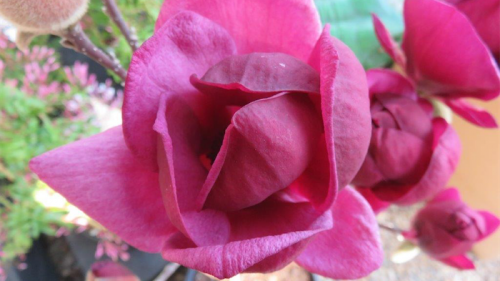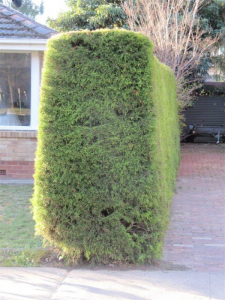
SPRING is in the air, daylight saving has started and it’s an exciting time to be in the garden.

Before buying new plants, it’s worth planning where they’re to be planted, thinking about the available space and if it’s in sun or shade.
Make a list and try to keep to it, which I know is easier said than done when one is confronted in garden centres by so many wonderful plants in flower.
It’s a good idea on hot days to take an old sheet and cover the plants when driving home.
And, once home, give the plants a thorough watering. With the best will in the world, not all plants get sufficient water while in the nursery and may be on the dry side.
Before planting, water the plants while still in the pots with Maxicrop Seaweed Plant Nutrient added. This is specifically for promotion of root growth, which is vital as the days heat up.
At planting time make a small mound of soil around the new plant to hold a minimum of a nine-litre bucket of water and fill this “moat” with water, to which more seaweed solution is added.
WITH spring comes the pests. For example, aphids are starting to mass not only on roses but also on the emerging fresh leaves of maples. Using chemical sprays to kill the aphids will also kill ladybirds, whose favourite diet is aphids! I recommend the natural spray made from the pyrethrum daisy such as Maxicrop Long Life Pyrethrum, which will last up to 20 days.
WE often think of a bird bath as an important addition to gardens, but forget about a shallow-water container, such as a plant saucer, for other inhabitants such as geckos, blue-tongue lizards and bees.
I recommend placing bird baths in an open position because when placed under trees and shrubs they quickly fill with leaves and, more importantly, birds can’t always see the friendly cat sitting in the tree waiting to pounce.

BUXUS or box hedging plants are now showing lots of new growth and flowers and this is one time to ignore the flowers and trim the plant into shape.
Normally the advice is to prune evergreen plants immediately after flowering, Buxus being the exception.
Years ago, the advice given for Aussie plants was not to feed, water or prune. The idea was that these plants have adapted over millennia to natural conditions.
However, those giving this advice did not take into account the huge variation in soils once we modern folk started developing gardens and amending soils.
So, today’s advice is to prune, feed and water Aussie plants the same as any other.
On pruning, the advice I like to give is prune immediately after flowering and do not take more than one third off at any one time. Many plants will respond to much heavier pruning with little ill effect. But some – in particular Aussie plants – can resent a too heavy hand with the shears or hedge clippers. So, up to (but not more than) one third off at any time. Apply a good organic plant food to the soil to boost the “take off” of new growth. Neutrog Seamungus, a combination of seaweed and chook poo (from free-range hens) is ideal and is classified as organic.
With glorious spring weather, the new shoots will soon start appearing. Pruning has the effect of producing more branches, resulting in denser growth and with flowering plants, more flowers the following season.

OCTOBER is also the ideal month for pruning conifers (and in March).
It is vital not to prune conifers too hard and never into the old wood. While most evergreen shrubs will bounce back if one gets carried away, not so conifers.
If you do cut into the old wood you will end up with a hedge of “old wood” with no greenery.
It is important with all evergreen hedges, whether pittosporum or conifer, to shape the top narrower than the base. This allows for even sunlight to the whole plant. If the hedge bulges out at the top, dieback can result at the bottom half of the hedge.
Jottings…
- Mulching is of the utmost priority without delay. I use and recommend Canberra Sand and Gravel’s “Canberra Organic Mulch”.
- When feeding plants, remember to feed the plant not the ground. Neutrog’s Seamungus either in pellet or liquid form is ideal. This is a combination of chicken poo and seaweed. Spread around the drip line away from the stems of the plant.
- “Grow contented plants and you will find peace in your garden” – Beth Chatto, well-known English gardener.
Who can be trusted?
In a world of spin and confusion, there’s never been a more important time to support independent journalism in Canberra.
If you trust our work online and want to enforce the power of independent voices, I invite you to make a small contribution.
Every dollar of support is invested back into our journalism to help keep citynews.com.au strong and free.
Thank you,
Ian Meikle, editor




Leave a Reply